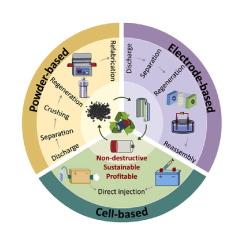Direct regeneration of spent lithium-ion batteries: Advancing from powder to cell
IF 14.9
1区 化学
Q1 Energy
引用次数: 0
Abstract
The rapid advancement of electric vehicles (EVs) has led to a substantial increase in spent lithium-ion batteries (LIBs), necessitating effective recycling pathways to recover the reusable battery components. Traditional recycling methods, such as pyrometallurgy and hydrometallurgy, represent battery-component destructive pathways with high energy consumption and substantial waste emissions, leading to considerable environmental issues. In contrast, direct regeneration technologies preserve the integrity of battery components on certain levels, offering a more sustainable and energy-efficient approach. However, these technologies are hindered by complex pre-treatment procedures, underscoring the need for a simplified route to effectively restore battery performance. This Review categorizes recent advancements in direct regeneration strategies at three levels—powder, electrode, and cell—focusing on their fundamental mechanisms, technological pathways, and socioeconomic sustainability. Among these, cell-level direct regeneration technologies exhibit the highest economic benefits and the lowest waste emissions, positioning them as a promising solution for large-scale battery recovery. By highlighting the potential of cell-level direct regeneration, this review aims to drive further research and development toward scalable and simplified strategies for the efficient reuse of spent LIBs.

废锂离子电池的直接再生:从粉末到电池的进步
随着电动汽车(ev)的快速发展,废旧锂离子电池(lib)的数量大幅增加,需要有效的回收途径来回收可重复使用的电池组件。传统的回收方法,如火法冶金和湿法冶金,代表了电池组件的高能耗和大量废物排放的破坏性途径,导致相当大的环境问题。相比之下,直接再生技术在一定程度上保持了电池组件的完整性,提供了一种更可持续、更节能的方法。然而,这些技术受到复杂的预处理程序的阻碍,因此需要一种简化的方法来有效地恢复电池的性能。本文从粉末、电极和细胞三个层面对直接再生策略的最新进展进行了分类,重点介绍了它们的基本机制、技术途径和社会经济可持续性。其中,电池级直接再生技术表现出最高的经济效益和最低的废物排放,使其成为大规模电池回收的有前途的解决方案。通过强调细胞水平直接再生的潜力,本综述旨在推动进一步研究和开发可扩展和简化的策略,以实现废lib的有效再利用。
本文章由计算机程序翻译,如有差异,请以英文原文为准。
求助全文
约1分钟内获得全文
求助全文
来源期刊

Journal of Energy Chemistry
CHEMISTRY, APPLIED-CHEMISTRY, PHYSICAL
CiteScore
19.10
自引率
8.40%
发文量
3631
审稿时长
15 days
期刊介绍:
The Journal of Energy Chemistry, the official publication of Science Press and the Dalian Institute of Chemical Physics, Chinese Academy of Sciences, serves as a platform for reporting creative research and innovative applications in energy chemistry. It mainly reports on creative researches and innovative applications of chemical conversions of fossil energy, carbon dioxide, electrochemical energy and hydrogen energy, as well as the conversions of biomass and solar energy related with chemical issues to promote academic exchanges in the field of energy chemistry and to accelerate the exploration, research and development of energy science and technologies.
This journal focuses on original research papers covering various topics within energy chemistry worldwide, including:
Optimized utilization of fossil energy
Hydrogen energy
Conversion and storage of electrochemical energy
Capture, storage, and chemical conversion of carbon dioxide
Materials and nanotechnologies for energy conversion and storage
Chemistry in biomass conversion
Chemistry in the utilization of solar energy
 求助内容:
求助内容: 应助结果提醒方式:
应助结果提醒方式:


